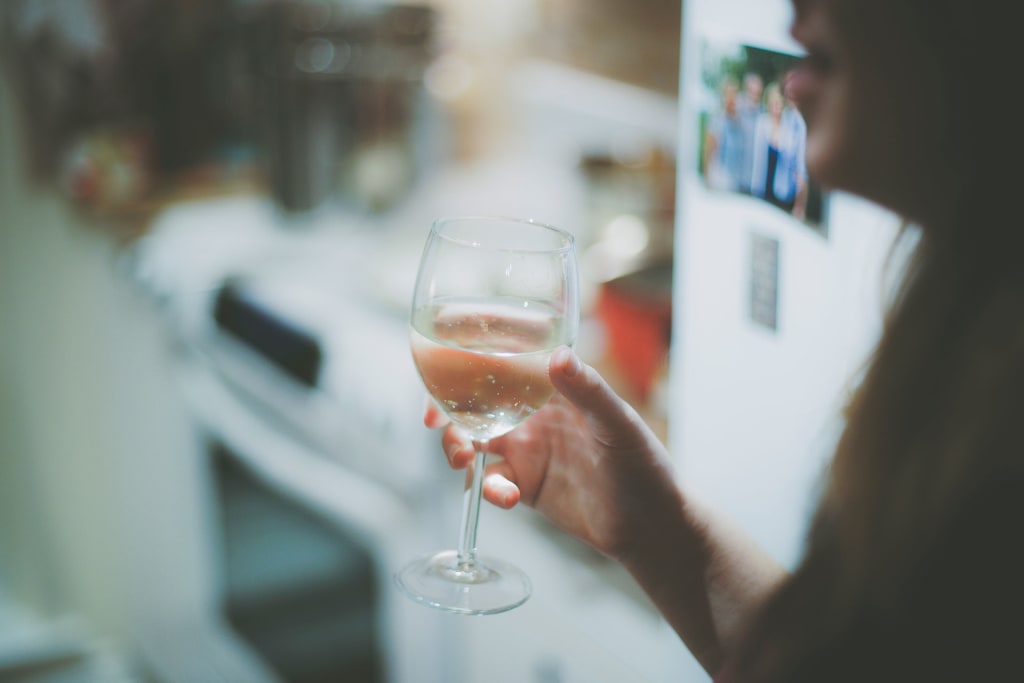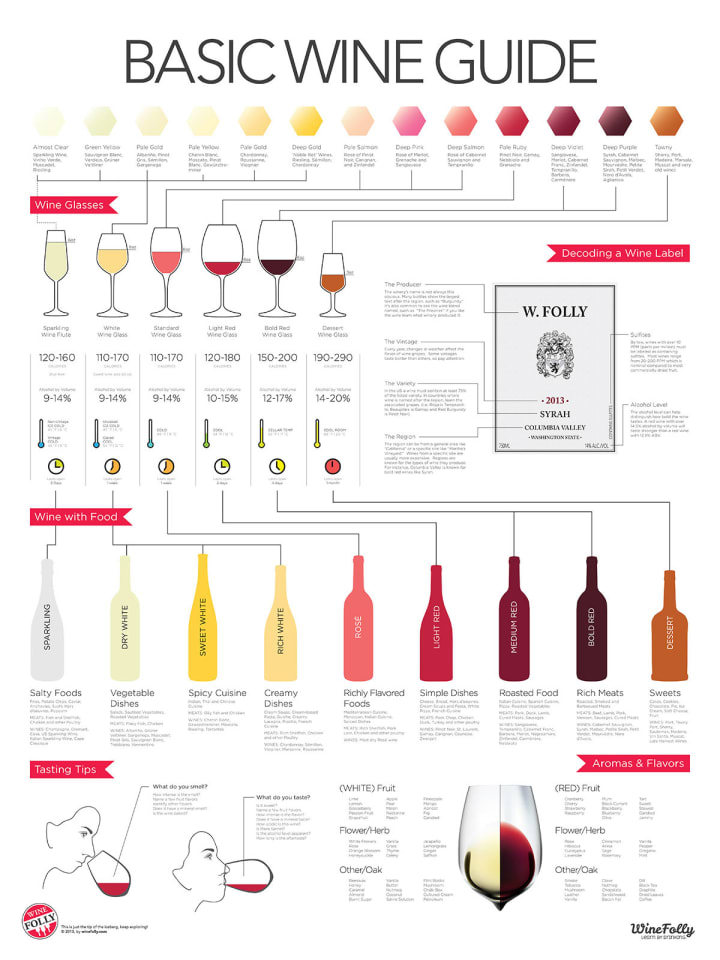Beginner's Guide to Wine Tasting
This guide to wine tasting is everything a real beginner should know.

Historically, just about everyone drank wine. Wine was actually cleaner and safer than water throughout most of human history, since the alcohol helped kill a number of germs. Since people noticed wine was less likely to give them food poisoning, both kids and pregnant women drank it.
But, wine was more than just a food staple. It was also a drink that often was equated with wealth, celebration, and hospitality. It was the favored drink of most early US presidents. Jesus allegedly turned water into wine. And, countless songs have been written about it.
People really do love their wine, and after a while, people began to notice that different grapes produce different wine flavors. And, then, after more time, different wine production methods began to arise.
Nowadays, tasting all the different flavors of wine and enjoying the scents of every varietal is a major hobby of foodie elites. But, how do you actually do it without looking like an idiot? This wine guide will help newbies learn the ropes with every single glass.
First things first...
In order to do wine tasting like a boss, you're going to need the following things:
- A notepad. To write down what you taste/smell/information, you may need one of these. Not everyone's into the writing part, so if you're not a scribe, skip it.
- At least three or four bottles of wine. Expensive is not a requirement. You can stick to one color of wine, or multiple. It's up to you.
- A friend. Wine tasting is best done with at least one friend.
- A set of wine glasses. Come on, don't be tacky. Taste wine in a wine glass. (Besides, the wine glass shape helps you pick up on smells.)
- A bucket of ice. This is only necessary if you have white wine, as white wine is the only one that needs to be chilled.
- A bottle opener. Corks are a thing, you know.
- A wine aerator. This is basically a small cork-like device that allows air to get back into the wine, which in turn releases the aromas stored up in wine. It's a good pick.
- A nice setup. This is technically optional, but I really do believe that the best way to enjoy wine is in a room that feels elegant, relaxed, and sophisticated.
- Cheese and/or chocolates. What's food without wine?
Now, let's talk about the different types of wines out there.

In order to taste wine, you have to understand a little bit about the different kinds of wine. To keep things simple, we're going to get into wine colors first.
Generally speaking, wine is organized into three different color types. They are red, white, and rose. Here's what you need to know about each type...
- Red wines are wines that are made with darker colored grapes. They tend to have bolder, earthier tastes that white or rose wines. Red wines are served at room temperature, and tend to pair well with meats, starchy foods, and cured meats.
- White wines are made with green grapes, and are actually a yellowish hue. They typically require chilling before serving because they tend to have a delicate, lighter, and fruitier flavor. White wines go well with seafood, fruit, desserts, and most salads.
- Roses are made from a blend of white and red grapes. And they tend to go decently with everything.
Now, let's get into varietals.
Varietals are basically "subgenres" of each wine color. Basically, this is a term that talks about the actual kind of grape that is used in order to make the wine you're tasting. And, more often than not, a varietal is only used in a single part of the world.
Each varietal tends to have a unique flavor and smell to it. And, those smells and flavors can change from year to year. These are the most well known wine varietals for each wine color:
Reds: Cabernet, Merlot, Bordeaux, Pinot Noir, Zinfandel, and Syrah.
Whites: Chardonnay, Pinot Grigio, Riesling, Sauvignon Blanc, and Moscato
Rose: Most rose wines are blends, so there's no particular varietal to speak of with them.
The point of wine tasting is to observe the wine in all five senses.

So, let's take a start by looking at the wine. Is it a rich, red color? Or, does it seem like a nearly crystalline Chardonnay? Take a note of it. This is part of the tasting.
Now, wine connoisseurs can actually tell an older, aged wine from a newer wine. The way they can tell is actually pretty simple. Older wines will have darker coloration at the bottom of the glass, simply because the wine's natural aromas will tend to separate slightly over time. Newer wines tend to be more uniform. Feel free to note if your wine's been aging or not in your notebooks.
A last thing to look for in your wine glass are bubbles. Obviously, if you have Champagne or sparkling wine, this isn't an issue. In fact, it's quite awesome to watch the bubbles float to the top.
On the other hand, if you have a wine that isn't supposed to have bubbles in it, this is actually a sign that you need to toss the bottle. Unwanted bubbles is a sign that the wine has gone bad. (Yes, wine can rot, too.)
Next sense to enjoy is the smell of the wine.

In order to really appreciate all the subtle notes in a wine glass, you're going to need to unlock all the flavors in it. To do this in a wine tasting, you're going to need to pour the wine into your glass using an aerator and then swirl the wine around in your glass. (Be gentle while swirling.)
Then, take a whiff. Really, truly concentrate on what you smell. Common "notes" you might notice in a wine's aroma include berries, roses, and even floral scents. Write down what you smell in each wine you taste.
Though it's possible to smell some pretty unusual stuff in a wine, there are certain scents that tend to signal that a wine's gone bad. If you notice any of these odors coming out of your wine, you have a wine gone bad:
- Vinegar. This is the most common smell that a wine gone bad will have, and it also signals that the wine you're holding would taste acrid if you sip it. Don't do it.
- Must. A wine that smells like a musty basement is not a wine you should ever taste. This is a sign that the wine may have impurities like mold or dust in it.
- Unusual Sweetness. A typical table wine shouldn't smell super sweet or syrupy. This is a sign that the wine's been exposed to a lot of heat and went bad.
- Chemicals. Does it smell like it could be used to clean a car seat? An astringent smell is a good sign that you need to ditch the wine.
- Cork. A corky smell is a sign that the cork ended up hurting the wine's flavor profile. Wine connoisseurs call this "corked wine," and it's an instant ditch.
Now, you can actually taste it.
After all that work, it's time to taste it. Sip it, let it swish around your mouth a little bit. Some wines may be earthy, others sweet. What does this wine taste like to you? Take note of it.
If you really want to go all-out, then take this time to enjoy the wine with a paired snack. Cheese and chocolates, for example, are common classics that work wonders with the right wines.
Lastly, discuss it.
After you've done all the tasting, swirling, and looking, you probably know which wine you like the most. Talk to your friends about what notes you noticed. Did they match up?
If you want to see what connoisseurs picked, look at the bottle's label. In most cases, there will be notes written down that were picked up by the professionals.
About the Creator
Mackenzie Z. Kennedy
Socialite and dating guru Mackenzie Kennedy knows all about the inner workings of people and society as a whole. It's not only her lifestyle - it's her passion. She lives in Hoboken with her pet dogs, Cassie and Callie.






Comments
There are no comments for this story
Be the first to respond and start the conversation.